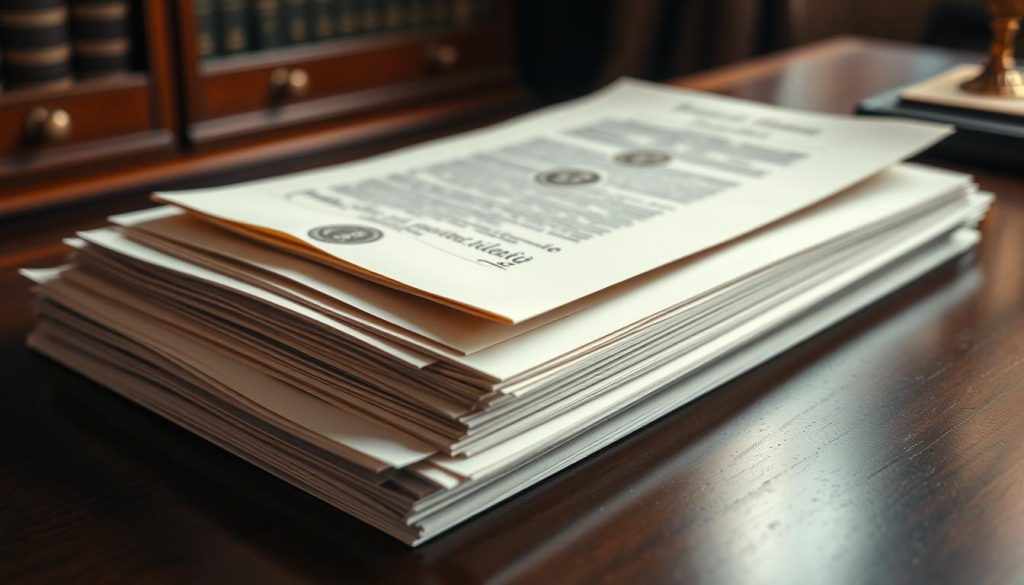When planning to pass assets to children after death, the natural inclination is often to leave an equal share to each child. However, there are situations where this may not be the most suitable approach.
Deciding how to distribute your estate among your children can be challenging, especially when considering uneven inheritances. In the UK, parents have the freedom to distribute their estate as they wish, but this can sometimes lead to disputes among beneficiaries.
A letter of wishes can be a valuable tool in explaining the reasoning behind your decisions, helping to prevent misunderstandings and ensuring that your wishes are respected.
Key Takeaways
- Parents in the UK have the freedom to distribute their estate as they wish.
- Uneven inheritances can lead to disputes among beneficiaries.
- A letter of wishes can help explain the reasoning behind your decisions.
- Clear communication can prevent misunderstandings among beneficiaries.
- Using a letter of wishes can ensure that your wishes are respected.
What is a Letter of Wishes?
In the UK, a letter of wishes serves as a guide for those managing your estate after you’re gone. It’s a document that provides additional context and explanations to help your executors and beneficiaries understand your intentions regarding the distribution of your assets.
Definition and Purpose
A letter of wishes is a non-legally binding document that accompanies your will. Its primary purpose is to offer guidance on how you wish your estate to be managed and distributed. This can include specific bequests, family heirlooms, or charitable donations. We believe that a well-crafted letter of wishes can significantly reduce the potential for misunderstandings among your loved ones.
The letter typically includes details about your assets, your relationships with beneficiaries, and any specific requests you may have. For instance, you might explain why you’re leaving a particular item to a specific individual or provide context for uneven distributions among beneficiaries.
Key Differences from a Will
While both a will and a letter of wishes are crucial estate planning documents, they serve different purposes. A will is a legally binding document that outlines how your assets should be distributed upon your death. In contrast, a letter of wishes is not legally binding but provides additional context and explanations to support your will.
To illustrate the differences, consider the following table:
| Characteristics | Will | Letter of Wishes |
|---|---|---|
| Legal Binding | Yes | No |
| Purpose | Distribute assets according to your wishes | Provide context and explanations for your decisions |
| Flexibility | More formal and less flexible | More flexible and can be updated easily |
As shown in the table, while a will is legally binding and outlines the distribution of your assets, a letter of wishes provides the necessary context to help your executors and beneficiaries understand your decisions.
Legal Status of Letters of Wishes in the UK
Letters of wishes, while not legally binding, hold considerable importance in UK estate administration. They serve as a guide for executors and beneficiaries, providing insight into the testator’s intentions regarding the distribution of their estate.

Are They Legally Binding?
In the UK, a letter of wishes is not considered a legally binding document. This means that executors are not obligated to follow the instructions outlined in the letter. However, they are expected to take it into account when administering the estate.
It’s essential to understand that the non-binding nature of letters of wishes allows for flexibility in estate administration. Executors can use their discretion when making decisions, taking into consideration the testator’s wishes as expressed in the letter.
Key aspects to consider:
- The letter provides guidance on the testator’s intentions.
- Executors have discretion in how they apply the wishes expressed.
- The letter can help prevent misunderstandings among beneficiaries.
How Courts View Letters of Wishes
Although not legally binding, courts in the UK may consider letters of wishes when resolving disputes related to the will. This is particularly relevant in cases where the will is contested or unclear.
Courts view letters of wishes as a reflection of the testator’s intentions and may use them to clarify any ambiguities in the will. It’s crucial that the letter is carefully drafted to ensure it accurately represents the testator’s wishes.
“A letter of wishes can be a valuable tool in estate planning, providing clarity and guidance for executors and beneficiaries alike.”
For those seeking UK inheritance letters advice, it’s clear that understanding the legal status and implications of letters of wishes is vital. By incorporating a well-drafted letter of wishes into their estate plan, individuals can ensure their intentions are respected and their estate is administered according to their wishes.
Reasons for Using Letters of Wishes
In the UK, using a letter of wishes can provide clarity on your estate distribution plans. This document allows you to explain the reasoning behind your decisions, ensuring that your executors and beneficiaries understand your intentions.
Providing Clarity for Executors
A letter of wishes serves as a guide for your executors, helping them navigate the complexities of your estate. By clearly stating your intentions, you can reduce the risk of misunderstandings or disputes among your beneficiaries.
- Explains the reasoning behind your inheritance decisions
- Provides context for unequal distributions among beneficiaries
- Helps executors manage your estate according to your wishes
For instance, if you decide to leave unequal shares to your children, a letter of wishes can clarify the reasons behind this decision, such as financial support needs or previous gifts.

Customising Inheritance Distribution
Using a letter of wishes allows you to customise the distribution of your estate according to your specific circumstances. This can be particularly useful in complex family situations or when you wish to support certain causes.
Key benefits include:
- Flexibility in explaining your decisions
- Ability to address specific family dynamics or needs
- Opportunity to include charitable intentions or special bequests
By using a letter of wishes, you can ensure that your estate is distributed in a way that reflects your personal values and circumstances, providing peace of mind for both you and your loved ones.
How to Draft an Effective Letter of Wishes
When it comes to estate planning, a well-crafted letter of wishes can provide invaluable guidance for your executors and beneficiaries. This document allows you to express your intentions and provide context for the decisions you’ve made regarding your estate.
Key Elements to Include
Drafting an effective letter of wishes requires careful consideration of several key elements. You should:
- Explain your decisions: Clearly state the reasoning behind your choices regarding the distribution of your estate.
- Provide context: Offer background information that may help your beneficiaries understand your wishes.
- Include specific requests: If you have particular desires regarding certain assets or charitable donations, make sure to include these in your letter.
- Address potential conflicts: If there are potential areas of contention among your beneficiaries, you may want to address these proactively in your letter.
Tone and Language Considerations
The tone and language used in your letter of wishes are crucial. You should aim for a tone that is:
- Clear and concise: Avoid using overly complex language or jargon that may confuse your beneficiaries.
- Sensitive and compassionate: Be mindful of the emotional impact your words may have on your loved ones.
- Personal and reflective: Your letter is an opportunity to share your thoughts and feelings with your family.
It’s also important to consider the language you use, ensuring it is consistent with your overall estate planning documents and reflects your wishes accurately.
Seeking Professional Guidance
While it’s possible to draft a letter of wishes on your own, seeking professional guidance can be highly beneficial. A solicitor or estate planning expert can:
- Provide legal insight: Ensure that your letter complements your formal will and other estate planning documents.
- Offer practical advice: Help you navigate complex family dynamics or sensitive issues.
- Ensure clarity and effectiveness: Review your letter to ensure it accurately reflects your wishes and is likely to be understood by your beneficiaries.
By following these guidelines and seeking appropriate guidance, you can create a letter of wishes that provides clear guidance and support for your loved ones during a difficult time.
Common Scenarios for Uneven Inheritance
Families often face complex decisions when it comes to dividing their assets unequally among beneficiaries. Uneven inheritance can occur due to various reasons, including differences in financial needs among beneficiaries or tax implications.
Reasons for Uneven Distribution
There are several reasons why individuals may choose to distribute their estate unevenly. Some common reasons include:
- Different financial needs among beneficiaries
- Gifts or financial assistance provided to beneficiaries during the testator’s lifetime
- Special needs or circumstances of certain beneficiaries
- Tax implications of equal distribution
Understanding these factors is crucial in making informed decisions about the distribution of one’s estate. It’s essential to consider the potential impact on family dynamics and the tax implications of uneven distribution.
Family Dynamics and Considerations
Family dynamics play a significant role in decisions regarding uneven inheritance. Factors such as the relationship between the testator and beneficiaries, as well as the beneficiaries’ individual circumstances, can influence distribution decisions.
Tax Implications to Consider
Tax implications are another critical factor to consider when deciding on uneven inheritance. The table below outlines some key tax considerations:
| Tax Consideration | Description | Impact on Uneven Inheritance |
|---|---|---|
| Inheritance Tax (IHT) | Tax on the estate’s value above the nil-rate band | Uneven distribution can help mitigate IHT liability |
| Capital Gains Tax (CGT) | Tax on gains from the sale of assets | Uneven distribution can affect CGT liability for beneficiaries |
| Income Tax | Tax on income received by beneficiaries | Uneven distribution can impact beneficiaries’ income tax liability |
By understanding these tax implications, individuals can make more informed decisions about uneven inheritance, ensuring that their wishes are carried out while minimizing tax liabilities.
Examples of Situations Addressed by Letters of Wishes
Estate planning can be challenging, especially in blended families or non-traditional relationships, but letters of wishes can help. In the UK, individuals facing complex family dynamics can benefit from the flexibility and clarity that letters of wishes provide.

Blended Families
Blended families often present unique challenges when it comes to estate planning. A letter of wishes can help clarify how assets should be distributed among step-children, biological children, and other family members. For instance, you might wish to leave a specific family heirloom to a step-child while ensuring that your biological children receive a fair share of your estate.
As one legal expert notes,
“A well-crafted letter of wishes can be the key to avoiding family conflicts and ensuring that your estate is distributed according to your true intentions.”
Non-Traditional Relationships
For individuals in non-traditional relationships, a letter of wishes can provide crucial guidance on how to distribute assets among partners, friends, or other beneficiaries who may not be recognized under traditional inheritance laws. This can be particularly important in cases where there are no formal marital or civil partnership arrangements.
- Explain your wishes clearly to avoid misunderstandings.
- Consider the tax implications of your decisions.
- Review and update your letter of wishes as circumstances change.
Charitable Intentions
Many individuals wish to leave a legacy by supporting charitable causes. A letter of wishes can outline your charitable intentions, specifying which organizations or causes you wish to support and how your donations should be used. This not only helps your executors but also ensures that your philanthropic goals are met.
By using a letter of wishes, you can provide NLP inheritance letters UK that are tailored to your specific situation, ensuring that your estate is distributed in a way that reflects your values and priorities. For UK inheritance letters advice, it’s essential to consult with professionals who understand the nuances of estate planning in the UK.
Benefits of Using Letters of Wishes
A letter of wishes is a document that can provide crucial guidance to your executors and beneficiaries in the UK. By outlining your intentions and the reasoning behind your decisions, you can ensure that your estate is distributed according to your wishes.
Enhancing Communication Among Beneficiaries
One of the primary benefits of a letter of wishes is its ability to enhance communication among your beneficiaries. By clearly stating your intentions, you can help prevent misunderstandings that might arise from the distribution of your estate.
For instance, if you decide to leave a larger portion of your estate to one child over another, a letter of wishes can explain the reasoning behind this decision, reducing the likelihood of conflict among your beneficiaries.
Mitigating Family Conflict
Family conflicts often arise when the distribution of an estate is not clearly understood. A letter of wishes can mitigate this by providing context to your decisions, helping to avoid disputes among your loved ones.
By explaining your wishes clearly, you can help your beneficiaries understand your intentions, reducing the potential for conflict. This can be particularly important in complex family situations, such as blended families or where there are non-traditional relationships.
Providing Context to Decisions
A letter of wishes allows you to provide context to the decisions you’ve made regarding the distribution of your estate. This can be invaluable in helping your executors and beneficiaries understand your intentions.
For example, you might choose to leave a specific item to a particular beneficiary because of a personal significance that item holds. By explaining this in your letter of wishes, you can ensure that your wishes are respected and understood.
| Benefit | Description |
|---|---|
| Enhanced Communication | Clearly stating your intentions to prevent misunderstandings among beneficiaries. |
| Conflict Mitigation | Providing context to your decisions to reduce the likelihood of family disputes. |
| Clear Intentions | Explaining the reasoning behind your decisions regarding the distribution of your estate. |
By utilizing a letter of wishes as part of your estate planning strategy in the UK, you can ensure that your wishes are clearly communicated to your beneficiaries, reducing the potential for conflict and ensuring that your estate is distributed according to your intentions.
Potential Issues with Letters of Wishes
As we explore the benefits of letters of wishes, we must also examine the potential drawbacks. While a letter of wishes can be a powerful tool in estate planning, particularly in the context of UK inheritance letters, it’s not without its challenges.
One of the primary concerns is the potential for misinterpretation or ambiguity. If the language used is not clear, beneficiaries may misunderstand the intentions behind the distribution of assets.
Misinterpretation and Ambiguity
A letter of wishes that is vague or open to multiple interpretations can lead to confusion among beneficiaries. To mitigate this risk, it’s crucial to use precise language when drafting a letter of wishes inheritance UK. Consider the following:
- Be specific about the assets being distributed
- Clearly state the reasons for any uneven distribution
- Avoid using ambiguous terms or jargon
Conflicts with Formal Wills
Another potential issue arises when there’s a conflict between the letter of wishes and the formal will. While the will is legally binding, a letter of wishes provides guidance to executors. However, if the two documents contradict each other, it can lead to legal challenges and family disputes.
Changing Circumstances
Circumstances can change over time, rendering a letter of wishes less relevant. For instance, changes in family dynamics, financial situations, or the birth of new beneficiaries can impact the original intentions. Regularly reviewing and updating the UK inheritance letters template can help ensure it remains relevant.
To minimize potential issues, it’s advisable to:
- Regularly review and update the letter of wishes
- Ensure the letter aligns with the formal will
- Communicate changes to beneficiaries
By being aware of these potential issues and taking steps to mitigate them, you can create a letter of wishes that effectively guides the distribution of your estate according to your wishes.
How to Keep Your Letter of Wishes Updated
Your letter of wishes should be a living document, reviewed and updated regularly to accommodate changes in your life and wishes. This ensures that your executors and beneficiaries are always aware of your current intentions regarding the distribution of your estate.
Regular Review and Revisions
It’s essential to establish a routine for reviewing your letter of wishes. Significant life events such as marriage, divorce, the birth of a child, or changes in your financial situation should prompt a review. Regular updates help ensure that your letter remains relevant and effective in guiding the distribution of your estate.
- Schedule a review every 2-3 years or as needed based on life events.
- Consider changes in your relationships with beneficiaries.
- Reflect on any alterations in your charitable intentions.
When revising your letter, it’s crucial to clearly indicate the date of the revision and to ensure that the new document supersedes any previous versions. This clarity helps prevent confusion among your executors and beneficiaries.
Communicating Changes to Beneficiaries
Once you’ve updated your letter of wishes, it’s a good practice to communicate these changes to your beneficiaries. This transparency can help manage expectations and reduce the potential for disputes.
| Beneficiary | Nature of Change | Reason for Change |
|---|---|---|
| John Doe | Increase in inheritance | Improved financial situation |
| Jane Smith | Specific bequest added | Personal significance of item |
By keeping your beneficiaries informed, you can foster a sense of trust and understanding, making the process smoother for everyone involved.
Examples of Letter of Wishes Templates
A letter of wishes template provides a useful structure for those looking to clarify their inheritance wishes. Using a template can be a good starting point for drafting your letter, providing a basic structure that you can customise according to your needs.
Basic Structure and Format
A typical letter of wishes template includes several key elements. These are:
- Introduction to the purpose of the letter
- Details of the assets being distributed
- Specific wishes regarding the distribution
- Any special requests or considerations
Here’s an example of what a basic template structure might look like:
| Section | Content |
|---|---|
| Introduction | State the purpose of the letter and your relationship to the beneficiaries. |
| Asset Distribution | List the assets and how you wish them to be distributed among beneficiaries. |
| Special Requests | Outline any specific wishes or conditions related to the inheritance. |
Customisation Options
While a template provides a basic structure, it’s essential to customise it to fit your specific circumstances. Consider the following:
- Family Dynamics: Take into account the relationships between beneficiaries and any potential conflicts.
- Specific Bequests: Clearly outline any specific gifts or bequests you wish to make.
- Charitable Donations: If you wish to include charitable donations, specify the charities and amounts.
By customising the template, you can ensure that your letter of wishes accurately reflects your intentions and circumstances.
Practical Tips for Personalisation
To make your letter of wishes more personal and effective, consider the following tips:
- Be Clear and Concise: Avoid ambiguity by using straightforward language.
- Include Relevant Details: Provide enough context for your executors and beneficiaries to understand your wishes.
- Review and Update: Regularly review and update your letter to reflect any changes in your circumstances or wishes.
By following these tips, you can create a letter of wishes that is both personal and practical, providing clarity for your loved ones in the future.
How Letters of Wishes Fit into Overall Estate Planning
In the UK, a comprehensive estate plan often includes a letter of wishes to complement your will and trusts. This document provides additional context and guidance, helping to ensure that your estate is managed and distributed in line with your intentions.
Integration with Wills and Trusts
A letter of wishes is not a standalone document; it works in conjunction with your will and any trusts you have established. By providing a clear expression of your wishes, it helps your executors and trustees make informed decisions about the distribution of your estate. For instance, if you have decided to leave certain assets to specific beneficiaries, your letter of wishes can explain the reasoning behind these decisions, reducing the likelihood of disputes among your loved ones.
We recommend that you review our guide on letters of wishes and inheritance to understand how it can be effectively used alongside your will.
Importance of Comprehensive Planning
Comprehensive estate planning is essential for protecting your assets and ensuring that your beneficiaries are well taken care of. A letter of wishes is a vital component of this process, as it provides a flexible and personal way to communicate your intentions. By including a letter of wishes in your estate plan, you can:
- Provide clarity on your wishes regarding the distribution of your estate
- Explain the reasons behind certain decisions, helping to prevent misunderstandings
- Ensure that your executors and trustees have the guidance they need to carry out your wishes effectively
By taking a comprehensive approach to estate planning, you can have peace of mind knowing that your loved ones will be taken care of according to your wishes.
Legal Advice on Letters of Wishes and Inheritance
Seeking legal advice is crucial when drafting a letter of wishes, especially if you’re unsure about any aspect of the process. We understand the importance of getting it right to ensure your wishes are respected and your loved ones are protected.
Seeking Professional Help
When to consult a solicitor? It’s advisable to do so when dealing with complex family dynamics or significant assets. Professional assistance can provide valuable guidance on letters of wishes guidance UK, helping you navigate the intricacies of UK inheritance letters.
Options for Professional Assistance
Various options are available for professional assistance, including solicitors specialising in estate planning and inheritance law. They can offer tailored advice on drafting letters of wishes inheritance UK, ensuring your letter is legally sound and effective.
Common Queries
Frequently asked questions often revolve around the legal status and implications of letters of wishes. Understanding these aspects is vital to making informed decisions about your estate planning.


